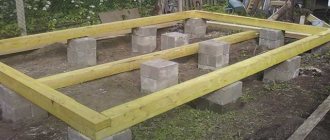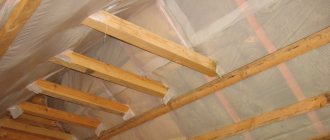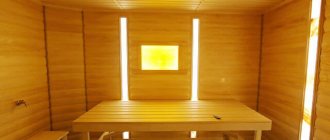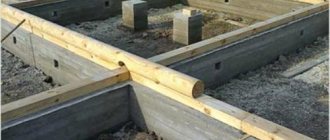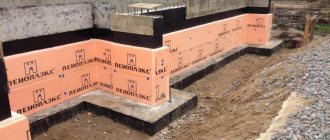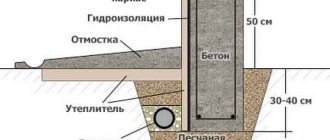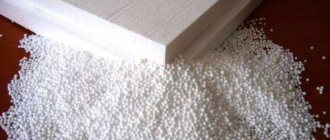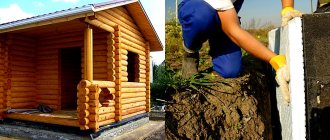began the history of Russian extruded polystyrene foam by launching in 1998 a production line for PENOPLEX boards at a plant in Kirishi, Leningrad Region.
Penoplex production method: Polystyrene granules enter an extruder, where they are heated and mixed under high pressure. At the same time, a gaseous blowing agent is supplied to the extruder. Thanks to high pressure and heat, the blowing agent enters the granules and increases their volume. The resulting mass is pressed through a die, the material is cooled and cut into slabs. As a result, small closed cells are formed in XPS, which give penoplex excellent thermal insulation properties and negligible water absorption.
Penoplex brands
- Penoplex COMFORT
- Penoplex BASE
- Penoplex FOUNDATION
- Penoplex GEO
- Penoplex ROOFING
- Penoplex FACADE
- Penoplex 45
Penoplex COMFORT
Overall dimensions: Length-1185 mm, width-585 mm, thickness 20; thirty; 40; 50; 100 mm.
TU 5767-006-54349294-2014
Orange color.
Surface: smooth.
PENOPLEX boards are packaged in heat-shrinkable UV-stabilized film.
Application of Penoplex COMFORT
It is used for thermal insulation of canopies, plinths, and pitched roofs. Strictly not applicable:
- in loaded structures.
Areas of application of Penoplex COMFORT:
- Roofs, walls, balconies, loggias.
- Thermal insulation of utilities.
- Insulation of livestock farms, cowsheds.
- For insulation of greenhouses.
Advantages of Penoplex COMFORT:
- Thermal conductivity coefficient is 0.032, hence high thermal insulation.
- Inertness to rotting, that is, resistance to fungi, mold, microorganisms.
- Resistant to temperature changes.
- Environmentally friendly, that is, it does not release harmful substances into the environment.
- Durable, up to 50 years of operation.
- Easy installation, convenient dimensions.
- Poor steam conductivity.
- Selected quarter (L-shaped edge). Allows you to join slabs like a construction set.
Penoplex COMFORT technical characteristics
| Name | Test method | Slab indicator |
| Compressive strength at 10% linear deformation, not less | GOST EN 826-2011 | 0.15 (1.5; 15) MPa |
| Water absorption in 24 hours, no more | GOST 15588-86 | 0.4% by volume |
| Water absorption in 28 days | 0.5% by volume | |
| Fire resistance category, flammability group | F3-123 | group G4 |
| Calculated thermal conductivity coefficient under operating conditions “B” | SP 50.13330.2012 | 0.032 W/(m×°K) |
| Sound insulation of partition (GKL-PENOPLEX® 50 mm-GKL), Rw | GOST 27296-87 | 41 dB |
| Improvement index for structural noise insulation in floor construction | GOST 16297-80 | 23 dB |
| Vapor permeability coefficient | 0.005 mg/(m.h.Pa) | |
| Density | from 20 kg/m3 | |
| Elastic modulus | 15 MPa | |
| Specific heat | 1.45 kJ/(kg.°C) | |
| Static bending strength | 0.25 MPa | |
| Standard sizes | Width | 585 mm |
| Length | 1185 mm | |
| Thickness | 20, 30, 40, 50, 100 mm | |
| Operating temperature range | THAT | -70 … +75 °С |
Where is it used?
The performance qualities of Comfort penoplex allow it to be used not only in a city apartment, but also in a private house. If you compare insulation with other building materials, you can notice significant differences. Similar insulating products have a narrower specialization of application: thermal insulation of walls or roofs.
Penoplex "Comfort" is a universal insulation material that is used for thermal insulation of balconies, foundations, roofs, ceiling structures, walls and floors. The insulation is also perfect for thermal insulation of baths, swimming pools, and saunas. Penoplex Comfort insulation is used for both internal and external construction work.
Almost any surface can be finished with Comfort insulating material: wood, concrete, brick, foam block, soil.
Penoplex BASE
Overall dimensions: Length-1185 mm, width-585 mm, thickness 20; thirty; 40; 50; 100 mm.
TU 5767-006-54349294-2014 amended. 1-6
Orange color.
Surface: smooth.
PENOPLEX boards are packaged in heat-shrinkable UV-stabilized film.
Application of Penoplex BASIS
This brand of penoplex is intended for insulation in civil and industrial construction, in walls, roofs, anywhere where there are no special loads on the structure being insulated.
Advantages of Penoplex BASIS:
- Low thermal conductivity.
- Almost no water absorption.
- Great compressive strength.
- Great bending strength.
- Environmentally friendly, that is, it does not release harmful substances into the environment.
- Durable, up to 50 years of operation.
- Inertness to rotting, that is, resistance to fungi, mold, microorganisms.
Penoplex OSNOVA technical characteristics
| Name | Test method | Slab indicator |
| Compressive strength at 10% linear deformation, not less | GOST EN 826-2011 | 0.17 (1.7; 17) MPa |
| Water absorption in 24 hours, no more | GOST 15588-86 | 0.4% by volume |
| Water absorption in 28 days | 0.5% by volume | |
| Fire resistance category, flammability group | F3-123 | group G4 |
| Calculated thermal conductivity coefficient under operating conditions “B” | SP 50.13330.2012 | 0.032 W/(m×°K) |
| Sound insulation of partition (GKL-PENOPLEX® 50 mm-GKL), Rw | GOST 27296-87 | 41 dB |
| Improvement index for structural noise insulation in floor construction | GOST 16297-80 | 23 dB |
| Vapor permeability coefficient | 0.005 mg/(m.h.Pa) | |
| Density | from 20 kg/m3 | |
| Elastic modulus | 15 MPa | |
| Specific heat | 1.45 kJ/(kg.°C) | |
| Static bending strength | 0.20 MPa | |
| Standard sizes | Width | 585 mm |
| Length | 1185 mm | |
| Thickness | 20; 30, 40, 50, 100, 120, 150 mm | |
| Operating temperature range | THAT | -70 … +75 °С |
Advantages and disadvantages
Advantages of insulation:
- Good thermal insulation properties.
- Low vapor permeability.
- Almost zero water absorption according to GOST 15 588−86. The material does not absorb moisture and evaporation, so it can be used to insulate baths and saunas.
- High strength. Penoplex can withstand significant tensile and compressive loads.
- Good sound insulation.
- The service life of the material is up to 50 years, during which the insulation retains all its properties and original shape.
- Even with a long service life, the material retains its chemical structure and does not decompose into toxic components, thereby not causing harm to humans and the environment.
- Biological resistance. Penoplex Base is not susceptible to rotting and mold.
- Easy to cut and install. The material can be cut well with a paint knife and does not require the use of special tools for working with sheets.
- You can insulate your home with Penoplex Base at any temperature at home or outside.
- Light weight material.
Disadvantages of penoplex Base:
- Unnatural origin.
- High price.
- Strong smoke.
Penoplex FOUNDATION
Overall dimensions: Length-1185 mm, width-585 mm, thickness 50; 100 mm.
TU 5767-006-54349294-2014
Orange color.
Surface: smooth.
PENOPLEX boards are packaged in heat-shrinkable UV-stabilized film.
Application of Penoplex FOUNDATION
Thermal insulation of deeply low (buried) places. Namely deep and shallow foundations, garden paths, septic tanks.
Swedish stove technology.
Engineering Communication.
Advantages of Penoplex FOUNDATION:
- Low thermal conductivity.
- Almost no water absorption.
- Great compressive strength.
- Great bending strength.
- Environmentally friendly, that is, it does not release harmful substances into the environment.
- Durable, up to 50 years of operation.
- Inertness to rotting, that is, resistance to fungi, mold, microorganisms.
Penoplex FOUNDATION technical characteristics
| Name | Test method | Slab indicator |
| Compressive strength at 10% linear deformation, not less | GOST EN 826-2011 | 0.3 (3.0; 30) MPa |
| Water absorption in 24 hours, no more | GOST 15588-86 | 0.4% by volume |
| Water absorption in 28 days | 0.5% by volume | |
| Fire resistance category, flammability group | F3-123 | group G4 |
| Calculated thermal conductivity coefficient under operating conditions “B” | SP 50.13330.2012 | 0.032 W/(m×°K) |
| Sound insulation of partition (GKL-PENOPLEX® 50 mm-GKL), Rw | GOST 27296-87 | 41 dB |
| Improvement index for structural noise insulation in floor construction | GOST 16297-80 | 23 dB |
| Vapor permeability coefficient | 0.005 mg/(m.h.Pa) | |
| Density | 27-35 kg/m3 | |
| Elastic modulus | 17 MPa | |
| Specific heat | 1.45 kJ/(kg.°C) | |
| Static bending strength | 0.4 MPa | |
| Standard sizes | Width | 585 mm |
| Length | 1185 mm | |
| Thickness | 50, 80 mm | |
| Operating temperature range | THAT | -70 … +75 °С |
The main criterion for choosing insulation
Insulation is selected according to its heat-protective ability. This property is quantitatively expressed in thermal conductivity, which shows how much thermal energy per second will be released from the room by one meter thick insulation when the temperature difference between inside and outside is one degree. Extruded polystyrene foam, from which PENOPLEX ® slabs of all brands are made, has low thermal conductivity: from 0.029 to 0.034 W/m•K. In this, the material is superior to other widely used thermal insulators - mineral wool and polystyrene foam, whose thermal conductivity, respectively, fluctuates in the ranges of 0.037–0.055 and 0.041–0.059 W/m•K. Thus, to create the same temperature conditions in a room, a layer of thermal insulation made of mineral wool or polystyrene foam will need to be 30–70% thicker than PENOPLEX ® slabs. Useful space is saved.
Penoplex GEO
Overall dimensions: Length - 1185 mm, width - 585 mm, thickness 40, 50, 60, 80, 100 mm.
TU 5767-006-54349294-2014 amended. 1-6
Orange color.
Surface: smooth.
PENOPLEX boards are packaged in heat-shrinkable UV-stabilized film.
Application of Penoplex GEO
This brand of penoplex is used for thermal insulation of loaded floors, foundations, roofs, stylobates, as well as in places where high fire resistance is not required. All these are areas of civil and industrial construction.
Advantages of Penoplex GEO:
- Low thermal conductivity.
- Almost no water absorption.
- Great compressive strength.
- Great bending strength.
- Environmentally friendly, that is, it does not release harmful substances into the environment.
- Durable, up to 50 years of operation.
- Inertness to rotting, that is, resistance to fungi, mold, microorganisms.
Penoplex GEO technical characteristics
| Name | Test method | Slab indicator |
| Compressive strength at 10% linear deformation, not less | GOST EN 826-2011 | 0.3 (3.0; 30) MPa |
| Water absorption in 24 hours, no more | GOST 15588-86 | 0.4% by volume |
| Water absorption in 28 days | 0.5% by volume | |
| Fire resistance category, flammability group | F3-123 | group G4 |
| Calculated thermal conductivity coefficient under operating conditions “B” | SP 50.13330.2012 | 0.032 W/(m×°K) |
| Sound insulation of partition (GKL-PENOPLEX® 50 mm-GKL), Rw | GOST 27296-87 | 41 dB |
| Improvement index for structural noise insulation in floor construction | GOST 16297-80 | 23 dB |
| Vapor permeability coefficient | 0.005 mg/(m.h.Pa) | |
| Density | 28-36 kg/m3 | |
| Elastic modulus | 17 MPa | |
| Specific heat | 1.45 kJ/(kg.°C) | |
| Static bending strength | 0.4-0.7 MPa | |
| Standard sizes | Width | 585 mm |
| Length | 1185 mm | |
| Thickness | 20, 30, 40, 50, 60, 80, 100, 120, 150 mm | |
| Operating temperature range | THAT | -70 … +75 °С |
Installation Tips
Insulation of external walls
- Preparatory work. It is necessary to prepare the walls, clean them of various contaminants (dust, dirt, old coating). Experts recommend leveling the walls with plaster and treating them with an antifungal agent.
- The insulation board is glued using an adhesive solution onto a dry wall surface. The adhesive solution is applied to the surface of the slab.
- Mechanical fastening of the slabs is carried out using dowels (4 pieces per 1 m2). In those places where windows, doorways and corners are located, the number of dowels increases (6-8 pieces per 1 m2).
- A plaster mixture is applied on top of the insulating board. For better adhesion of the plaster mixture and insulating material, it is necessary to make the surface slightly rough and corrugated.
- Plaster can be replaced by finishing with siding or wood.
If it is impossible to provide thermal insulation from the outside, then the insulation is installed indoors. Installation is carried out in a similar way, but a vapor barrier is placed on top of the insulating material. Foil-coated polyethylene film is suitable for this purpose. Next, they install the gypsum boards, onto which wallpaper can be glued in the future.
In the same way, work on insulating balconies and loggias is carried out. The joints of the plates are glued with special tape. After installing the vapor barrier layer, the joints are also taped, creating a kind of thermos.
Insulation of floors with Comfort penoplex under screed may vary in different rooms. The rooms located above the basements have a colder floor, so thermal insulation will require a larger number of insulating layers.
- Preparatory work. The floor surface is cleaned of various contaminants. If there are cracks, they are sealed. The surface should be perfectly flat.
- The prepared floors are treated with a primer mixture.
- For those rooms that are located above the basement, it is necessary to perform waterproofing. A mounting tape is glued along the perimeter of the room at the bottom of the walls, which compensates for the thermal expansion of the floor screed.
- If there are pipes or cables on the floor, a layer of insulation is first laid. After that, a groove is made in the slab, in which communication elements will be located in the future.
- When the insulation boards are laid, it is necessary to install reinforced polyethylene film on top of the layer. This is necessary to protect the insulating material from moisture.
- A reinforcing mesh is laid on top of the waterproofing layer.
Penoplex ROOFING
Overall dimensions: Length - 1185 mm, width - 585 mm, thickness 30, 40, 50, 60, 80, 100 mm.
TU 5767-006-54349294-2014 amended. 1-6
Orange color.
Surface: smooth.
PENOPLEX boards are packaged in heat-shrinkable UV-stabilized film.
Application of Penoplex ROOFING
Penoplex ROOF is used for insulation of load-bearing roof structures of any type. Including for thermal insulation of stylobates and parking lots.
Advantages of Penoplex ROOFING:
- Low thermal conductivity.
- Almost no water absorption.
- Great compressive strength.
- Great bending strength.
- Environmentally friendly, that is, it does not release harmful substances into the environment.
- Durable, up to 50 years of operation.
- Inertness to rotting, that is, resistance to fungi, mold, microorganisms.
Penoplex ROOF technical specifications
| Name | Test method | Slab indicator |
| Compressive strength at 10% linear deformation, not less | GOST EN 826-2011 | 0.25 (2.5; 25) MPa |
| Water absorption in 24 hours, no more | GOST 15588-86 | 0.4% by volume |
| Water absorption in 28 days | 0.4% by volume | |
| Fire resistance category, flammability group | F3-123 | group G4 |
| Calculated thermal conductivity coefficient under operating conditions “B” | SP 50.13330.2012 | 0.032 W/(m×°K) |
| Sound insulation of partition (GKL-PENOPLEX® 50 mm-GKL), Rw | GOST 27296-87 | 41 dB |
| Improvement index for structural noise insulation in floor construction | GOST 16297-80 | 23 dB |
| Vapor permeability coefficient | 0.005 mg/(m.h.Pa) | |
| Density | 26-34 kg/m3 | |
| Elastic modulus | 17 MPa | |
| Specific heat | 1.45 kJ/(kg.°C) | |
| Static bending strength | 0.4 MPa | |
| Standard sizes | Width | 585 mm |
| Length | 1185 mm | |
| Thickness | 20, 30, 40, 50, 60, 80, 100, 120, 150 mm | |
| Operating temperature range | THAT | -70 … +75 °С |
Technical characteristics of insulation
When choosing thermal insulation, you need to pay attention to 2 main technical characteristics:
- Coefficient of thermal conductivity . The lower it is, the better, because the material is needed to retain heat inside the room, and not to “heat the street.”
- Moisture absorption level . A low score is good. This means that the polymer does not absorb water and, as a result, lasts longer.
“ Penoplex Osnova ” differs from other types of insulation in its decent strength, long service life and structural stability. According to research results, insulation is 1.5 - 2 times higher than the energy efficiency of polystyrene foam and mineral wool.
Penoplex FACADE
Overall dimensions: Length - 1185 mm, width - 585 mm, thickness 20, 30, 40, 50, 60, 80, 100, 120, 150 mm.
TU 5767-006-54349294-2014 amended. 1-6
Orange color.
Surface: smooth.
PENOPLEX boards are packaged in heat-shrinkable UV-stabilized film.
Application of Penoplex FACADE
It is used as thermal insulation for insulation of internal and external surfaces, that is, facade systems, walls, wall partitions). Penoplex FACADE is designed with a milled surface, which facilitates the adhesion of plaster and glue to the surface and reduces the time required for plastering the building facade.
Advantages of Penoplex FACADE:
- Low thermal conductivity.
- Almost no water absorption.
- Great compressive strength.
- Great bending strength.
- Environmentally friendly, that is, it does not release harmful substances into the environment.
- Durable, up to 50 years of operation.
- Inertness to rotting, that is, resistance to fungi, mold, microorganisms.
Penoplex FACADE technical characteristics
| Name | Test method | Slab indicator |
| Compressive strength at 10% linear deformation, not less | GOST EN 826-2011 | 0.2 (2.0; 20) MPa |
| Water absorption in 24 hours, no more | GOST 15588-86 | 0.4% by volume |
| Water absorption in 28 days | 0.5% by volume | |
| Fire resistance category, flammability group | F3-123 | group G3 |
| Calculated thermal conductivity coefficient under operating conditions “B” | SP 50.13330.2012 | 0.032 W/(m×°K) |
| Sound insulation of partition (GKL-PENOPLEX® 50 mm-GKL), Rw | GOST 27296-87 | 41 dB |
| Improvement index for structural noise insulation in floor construction | GOST 16297-80 | 23 dB |
| Vapor permeability coefficient | 0.005 mg/(m.h.Pa) | |
| Density | 25-33 kg/m3 | |
| Elastic modulus | 15 MPa | |
| Specific heat | 1.45 kJ/(kg.°C) | |
| Static bending strength | 0.25 MPa | |
| Standard sizes | Width | 585 mm |
| Length | 1185 mm | |
| Thickness | 20, 30, 40, 50, 60, 80, 100, 120, 150 mm | |
| Operating temperature range | THAT | -70 … +75 °С |
Insulation technology
Penoplex Base is excellent for insulating both floors and walls.
Insulation of a wooden floor with joists
Firstly, all damaged areas on the boards and joists are replaced.
Next, all wooden surfaces are impregnated with antiseptic agents to prevent rotting. Recesses and cracks found on the boards must be filled with special wood putty. Next, all wood surfaces are primed. After the primer has dried, the installation of insulation sheets begins. They are cut according to the distance between the joists and the length of the room and placed on boards.
The joints between the foam boards should remain as tight as possible; they are additionally secured with construction tape. Next, sheets of vapor barrier material are laid overlapping on the foam boards. Boards, plywood or chipboard are attached to the vapor barrier layer. The final stage is the installation of flooring (linoleum, laminate, parquet).
Floor insulation when laid on the ground
When insulating floors in a house with a pile or strip foundation, the method of laying insulating material on the ground is used. First, you need to level the layer of earth and then compact it.
Next, crushed stone and gravel are poured onto the ground. Sand is then poured in and compacted. Penoplex sheets are laid on the sand “pillow”, starting from the corner, pressing tightly.
To protect against moisture penetration, a waterproofing membrane is laid on the foam sheets so that its edges extend 10-15 cm up the wall.
To strengthen the structure, the screed is reinforced with metal mesh. Next, a cement-sand mixture is used for the screed, which is poured over the mesh. Finally, after the cement layer has completely dried, linoleum is laid on it or laminate or parquet is laid.
Insulating the floor under the screed
When using this method of insulation, it is recommended to choose the Foundation modification of penoplex.
Insulation of walls from the inside
Penoplex Base is often used when insulating the internal walls of a house. Firstly, the walls are cleaned of the old coating and a layer of primer is applied. Next, they begin to attach the foam sheets to the walls.
First, the underside of the base foam sheet is passed with a needle roller to ensure better adhesion. Next, an adhesive layer is applied to the sheet, the sheet is applied to the wall surface and held for half a minute.
Gluing begins from the bottom corner, then moving up and to the side. The glued foam sheets are additionally fixed with plastic dowels with an umbrella cap. After the glue has dried, use foam to fill the gaps between the sheets.
Important: recesses more than a centimeter wide must be filled with scraps of foam sheets.
At the next stage, the fiberglass plaster mesh is attached with glue or using dowels. Next, a leveling layer of plaster is applied, and then a finishing layer of putty. Finally, the surface is painted or wallpaper is glued to it.
Insulation of external walls
When insulating the walls of buildings and structures from the outside, it is recommended to use Penoplex Facade, which contains special flame retardant substances to reduce the risk of fire.
Penoplex 45
Overall dimensions: Length - 1185 mm, width - 585 mm, thickness 40, 50, 60, 80, 100 mm.
TU 5767-006-56925804-2007 amended. No. 1-6
Orange color.
Surface: smooth.
Plates 45 are packaged in heat-shrinkable UV-stabilized film.
Application of Penoplex 45
Wherever there are special requirements for the heaviest loads. This, for example, is the construction of airfield runways and roads.
Advantages of Penoplex 45:
- Low thermal conductivity.
- Almost no water absorption.
- Great compressive strength.
- Great bending strength.
- Environmentally friendly, that is, it does not release harmful substances into the environment.
- Durable, up to 50 years of operation.
- Inertness to rotting, that is, resistance to fungi, mold, microorganisms.
Penoplex 45 technical characteristics
| Name | Test method | Slab indicator |
| Compressive strength at 10% linear deformation, not less | GOST EN 826-2011 | 0.5 (5.0; 50) MPa |
| Compressive strength at 2% linear deformation, not less | GOST R EN 1606 | 0.19 (1.9; 19) MPa |
| Water absorption in 24 hours, no more | GOST 15588-86 | 0.2% by volume |
| Water absorption in 28 days | 0.5% by volume | |
| Fire resistance category, flammability group | F3-123 | group G3 |
| Calculated thermal conductivity coefficient under operating conditions “B” | SP 50.13330.2012 | 0.032 W/(m×°K) |
| Vapor permeability coefficient | 0.005 mg/(m.h.Pa) | |
| Density | 38-47 kg/m3 | |
| Elastic modulus | 20 MPa | |
| Specific heat | 1.45 kJ/(kg.°C) | |
| Static bending strength | 0.35-0.7 MPa | |
| Standard sizes | Width | 600 mm |
| Length | 1200/2400 mm | |
| Thickness | 40, 50, 60, 80, 100, 120, 150 mm | |
| Operating temperature range | THAT | -70 … +75 °С |
Safety first
There are no toxic components in the composition of PENOPLEX ® boards. In their production, the same grades of polystyrene are used as for the manufacture of children's toys, food packaging and medical products. Materials for the food and medical industries are subject to strict sanitary standards. Consequently, PENOPLEX ® does not pose a danger to human health. We also note that plastic processing waste is not used in its production; only virgin polystyrene is used.
PENOPLEX ® is certified with a high degree of environmental safety. The slabs are painted orange, which symbolizes warmth and environmental friendliness.
Slab sizes
Extruded insulation is available in the form of slabs of standard parameters, which are easy to install and also easy to cut to the required size.
- 50x600x1200 mm – 7 slabs per package;
- 1185x585x50 mm – 7 slabs per package;
- 1185x585x100 mm – 4 slabs per package;
- 1200x600x50 mm – 7 slabs per package;
- 1185x585x30 mm – 12 slabs per package.
Soil requirements
The vegetable is very demanding on soil fertility, moisture and acidity. He does not like clayey, sandy, wetlands. Grows well in soil with a neutral and slightly acidic reaction within the range of 6.2-7.5 pH.
Preparing the site before sowing seeds requires completely clearing the ground of weeds. After 2 weeks, repeat weeding the newly grown grass. Continuous herbicides will help clear the area of perennials. They should be used in the fall, after harvesting.
Deep plowing and loosening of the subsoil layer are carried out on the cleared plot of land. In the fall, when digging, add organic fertilizers (compost) and wood ash. In the spring, before planting, nitrogen, potassium, and phosphorus are added to the soil.
Briefly about the main thing
Insulation plays an important role in construction and renovation. You can find a huge number of insulation materials on the market, each of which has its own characteristics and disadvantages.
“Technoplex” and “Penoplex” are similar in technical characteristics. Both materials have high density and can withstand significant weight, and are characterized by low vapor permeability and thermal conductivity. They also have similar disadvantages. Both insulation materials ignite easily and release hazardous substances.
The choice is most often made in favor of Penoplex. This is due to the low price and the ability to use sheets for external insulation.
Other materials can be used for insulation: mineral wool, polystyrene foam and others. Each of them has its own characteristics.
Ratings 0
Application Limit
Features of the use of PENOPLEX COMFORT ® and PENOPLEX ® WALL are contained in their names. The first involves creating comfort, the second is intended for thermal insulation of wall structures. Let's consider the areas of application of these two products recommended by the company.
The scope of application of PENOPLEX COMFORT ® is as follows:
- insulation of apartment walls;
— thermal insulation of heated floors is allowed ("warm floor" system);
— thermal insulation of pitched roofs.
The first item on the list of areas of responsibility for PENOPLEX COMFORT ® are walls, which can be confusing. To prevent this from happening, let's look at the similarities and differences between the two brands.
They have the same technical characteristics. They differ from each other only in the texture of one flat surface. The PENOPLEX COMFORT ® slab has both smooth surfaces, while the PENOPLEX ® WALL has one rough surface, which is achieved by factory milling. Why process a smooth surface and thereby increase the cost of the product? Where is it appropriate to use it?
How to attach
Where to buy PENOPLEX® thermal insulation?
is a manufacturer of thermal insulation; distributors sell products. On the website, in the “Where to buy” section, you can select: country, city, partner status and select the supplier closest to you. You can also order PENOPLEX® products in the online store
How to attach PENOPLEX® thermal insulation?
The method of fastening PENOPLEX® directly depends on the structure in which thermal insulation is used.
— When insulating structures located below ground level, such as foundations, plinths, blind areas, preliminary adhesive fixation and weighting using backfilling of soil is sufficient.
— When thermally insulating a floor under a screed, PENOPLEX®, in principle, does not require any fastening.
— As for the walls, preliminary adhesive is required, as well as mandatory mechanical fixation, for which disc-shaped dowels are usually used. In some special cases, mechanical fixation of PENOPLEX® slabs using lathing is possible.
Basic recommendations for installing PENOPLEX® boards with PENOPLEX® FASTFIX® glue
1. It is advisable to make notches on the surface of the slab or process it so that it becomes rough.
2. Special PENOPLEX® FASTFIX® adhesive is intended for installation of PENOPLEX® thermal insulation. Recommended method of application: in even stripes around the perimeter at a distance of 1-3 cm from the edge and along the slab in the middle.
3. To attach PENOPLEX to the facade, in addition to adhesive, it is necessary to also use mechanical fixation.
Basic recommendations for installing PENOPLEX® slabs on dowels
1. To ensure good thermal insulation ability, disc dowels made of synthetic materials with low thermal conductivity are used in the facade system, which prevent the formation of cold bridges.
2. As a spacer element for disc dowels, driven or screw-in spacers made of galvanized or stainless steel with a thermally insulating plastic head are used, which minimizes heat loss.
3. The hole for the dowel is drilled 10-15 mm deeper than the driven part of the dowel itself.
4. If the base consists of heavy concrete, then the minimum length of the spacer part of the dowel entering the wall should be 45 mm. In solid brick masonry, the depth of fixing the dowel is 60-70 mm, in hollow brick masonry - 80-90 mm. In bases made of foam or gas silicate blocks, it is required to fasten to a depth of at least 100 or 120 mm (with a dowel diameter of 8 and 10 mm, respectively).
5. If PENOPLEX® thermal insulation is attached to a waterproofing layer, then it is necessary to use weld-on fasteners instead of dowels.
How does PENOPLEX BASE® differ from PENOPLEX COMFORT®?
The main differences between PENOPLEX® materials are in different areas of application. Thermal insulation PENOPLEX OSNOVA® is used at industrial and civil construction sites.
PENOPLEX COMFORT® slabs are intended for private housing construction. They are used for insulation of country houses or city apartments in structures where special load requirements are not imposed. PENOPLEX COMFORT® boards can be purchased at hardware stores.
Does PENOPLEX® burn? What is its flammability class?
The PENOPLEX® material has a flammability group of G4. At the same time, many design solutions developed using PENOPLEX® thermal insulation have a fire hazard class of K0.
Design solutions indicating the fire hazard class can be found at RAPEX STO:
Technical solutions for roofing systems are separately described at the link on the website:
How to insulate a loggia/balcony?
The basic principles and recommendations for insulating balconies and loggias can be found by following the link:
What thickness of PENOPLEX® should I choose?
The thickness of the insulation is a very important parameter that must be calculated based on the region in which the work is being carried out, the purpose of the object (residential building or outbuilding), as well as the existing materials of the enclosing structure.
All these values can be taken into account in our calculator on the website and find out the required minimum value of thermal insulation thickness for your case. In addition, the calculator allows you to make an aggregate calculation of the total number of slabs.
How to buy PENOPLEX® 35?
How many slabs does PENOPLEX® FASTFIX® adhesive last for?
One bottle of PENOPLEX® FASTFIX® glue is enough for 100 linear meters of seam. We recommend applying PENOPLEX® FASTFIX® adhesive in one strip in the middle of the slab and along its perimeter, at a distance of 1-3 cm from the edge. With this method of application, one cylinder of PENOPLEX® FASTFIX® is enough for gluing up to 10 m2 of PENOPLEX® boards.
What is the volume of packaging, what is the volume of slabs?
In the “Catalogue” section of our website you can find data on the filling and occupied volume of packaging of slabs of all brands of PENOPLEX®.
Where can I find the price? What is the price?
is a manufacturer, we work through a network of regional dealers, the list of which is located at the link: “Where to buy”
You can also check prices and order PENOPLEX® products on the official online store
How much does 2 cm of foam replace?
In order not to bother with calculations, there is an approximate ratio for replacing building stone with polystyrene foam. It is possible to replace a 370 mm brick wall with a 2 cm thick foam block.
Interesting materials:
When and what teeth do children lose? When and by whom was Donetsk founded? When and why are mirrors covered? When will Elon Musk launch a rocket to Mars? When is an individual entrepreneur exempt from paying insurance premiums? When will Lucifer get his wings back? When did Chloe see Lucifer's face? When do they go for Christmas? When to apply false eyelashes before or after makeup? When is the Constitution considered adopted?
Rough nuance
This is advisable where a rough surface is indispensable. PENOPLEX ® WALL slabs are used for thermal insulation of walls with finishing without mechanical fastening. In other words, where the finishing material cannot be attached using nails or dowels with self-tapping screws, but you have to rely only on adhesive forces (adhesion). We are talking about finishing with plaster and tiles.
Let us remind you that the plaster system is erected as follows. A layer of base plaster-adhesive composition is applied to the heat-insulating layer of PENOPLEX ® slabs with a rough surface, reinforcing mesh is embedded into it, then, after drying, a facade primer is applied and, finally, a finishing layer of decorative and protective plaster. Therefore, for the reliability of such a plaster system, high adhesion (adhesion strength) of the insulation surface with the basic plaster and adhesive compositions is required. On the rough side of the PENOPLEX ® WALL slab, this figure is, of course, significantly higher than on the smooth surface of PENOPLEX ® slabs and the surfaces of other heat-insulating materials. In particular, it exceeds the adhesion of polystyrene foam by more than 1.5 times, and that of mineral wool by more than 2.5 times. It is important to note that the adhesive strength of the rough surface of PENOPLEX ® WALL is 3 times higher than the standard value specified in the technical specifications for the use of adhesive compositions.
Thus, PENOPLEX ® WALL slabs are intended for wall insulation with subsequent finishing with various types of plaster: cement, lime, lime-gypsum, cement-lime, polymer-cement, acrylic, etc. At the same time, PENOPLEX ® WALL can be used both for external insulation with plastered wall, and internal with wall decoration with interior decorative plaster.
An example of a wall design with thermal insulation PENOPLEX ® WALL and external finishing with plaster on a polymer mesh.
PENOPLEX ® WALL is a highly specialized insulation, in contrast to PENOPLEX COMFORT ®, which can be called a wide-profile insulation.
Concluding the story about the differences between the brands PENOPLEX COMFORT ® and PENOPLEX ® WALL, we note another important possibility of using thermal insulation. PENOPLEX ® WALL slabs go on sale with a factory-quality rough surface. However, you can prepare the slab for applying the plaster composition yourself. To do this, immediately before installation, notches are applied to PENOPLEX COMFORT ® boards to improve adhesion. But it is more advisable to purchase specialized PENOPLEX ® WALL boards, which are prepared for plastering work in the factory.
What is the difference between the types
Fodder (beet) and sugar beets differ from each other in many respects. It's not just about the appearance, but also about the composition, as well as the scope of application. So, let's take a closer look at the main differences between these subspecies.
Chemical composition
This is the most important quality indicator of a vegetable. Fodder beets contain 5-8 g of carbohydrates, 9 g of proteins and 1 to 3% sucrose.
Sugar beets have a completely different composition: 20 g of carbohydrates, 0.12 g of protein and about 20% sucrose. This group of root beet varieties was developed through selective breeding. At the beginning of the 19th century, the sugar concentration in sugar beets was only 5-7%.
Differences in depth of growth
The first sign by which sugar beets can be distinguished from fodder beets is the depth of growth. Sweet root vegetables are always completely in the soil, with only the tops outside.
The fodder is usually located a few centimeters above the ground, sometimes even two-thirds of the length of the entire vegetable without tops. Because of this, the above-ground part of fodder beets fades in the sun. It also makes manual harvesting easier, which cannot be said about machine harvesting.
Appearance
It is also easy to understand by appearance which vegetable is in front of you. So, what is the visual difference between one variety and another?
Sugar beet:
- elongated shape;
- color white, beige, gray;
- the tops are dense (50-60 leaves), green;
- the leaves are small, inconspicuous, light green.
Fodder beet:
- round or oval shape;
- color red, pink, orange;
- the tops are less dense (35-40 leaves), beet-colored, green;
- the leaves are small, ovoid, glossy, green.
Features of care
At this point, we’ll start with the choice of soil, since fodder and sugar beets have different requirements.
Chernozem and sierozem soils and peat bogs are suitable for sugar varieties. Before planting them, it is advisable to grow winter wheat or barley in the intended location. The soil horizon should ideally hold water at a depth of 70 cm.
Forage varieties feel better on slightly alkaline, saline soils. Chernozem will also suit them. The main thing is high fertility and additional feeding. The predecessor crops of beetroot in the garden are cereals, vegetables or legumes.
Rules for caring for sugar beets:
- During germination of seedlings, two thinnings are made - by 5-6 cm and by 15-18 cm.
- Abundant watering immediately after sowing.
- Regular weeding.
- Application of fungicide and insecticide to protect against pests during the growing season.
Rules for caring for fodder beets:
- A few days after sowing and after rain, loosening is carried out.
- It is necessary to weed several times during the growing season.
- Avoid watering a month before digging.
- Use mineral fertilizers.
- Apply Nitroammofoska to the soil before planting.
Productivity
This indicator also varies between beet and sugar varieties. In the first case, the average harvest amount is 30-60 tons per hectare of land. In the second - 15-30 tons.
The best varieties of beetroot:
- Lada;
- Hope;
- Milan;
- Vermont;
- Jamon;
- Starmon.
The best sugar varieties:
- Bohemia;
- Bona;
- Araksia;
- Big Ben.
Other brands of extruded polystyrene foam
These brands are available to order. The price and other terms of delivery are agreed with the client.
All data on the sale of polystyrene foam presented on the website is for informational purposes only and does not constitute a public offer.
ABOUT WHAT
Penoplex - thermal insulation made of extruded polystyrene foam. Let's look at the difference between a professional line and a line for individual construction.
Penoplex: The difference between professional thermal insulation and thermal insulation for individual construction
One of the leaders in the thermal insulation market is Russian, producing various types of insulation for use by professionals and private builders.
Types of Penoplex
- For professional construction. The products are used for insulation of buildings for various purposes, for the construction of roads, railway tracks, and for laying pipelines;
- For insulation of residential buildings.
Each type of thermal insulation has its own advantages, but the main advantages of the material are:
- low level of thermal conductivity; complete absence of water absorption; high flexural and compressive strength; environmental friendliness; resistance to all types of biological influences (fungi, mold); durability.
Thermal insulation for professionals
Thermal insulation for professionals is used for insulation of production, industrial and transport facilities, warehouse complexes, etc. Product types:
- "Penoplex Geo". Used to reduce heat loss in buried structures. Penoplex Geo should be purchased to protect structures from freezing when installing a wall-mounted garage. The material also helps reduce groundwater pressure on the foundation;
“Penoplex Osnova” is a universal material; it is used to insulate all elements of building structures. With its help, you can efficiently insulate the floor. If you do not have high load requirements, then it makes sense to buy Penoplex Basis. The price for Penoplex Basis is low.
"Penoplex Roofing" is intended for roofing work, thermal insulation of stylobates and parking lots. The advantages of the material, in connection with which it is worth choosing and buying Penoplex Roofing, are high flammability and compressive strength. It can be replaced with expanded polystyrene GEO or OSNOVA;
"Penoplex Slope" is used in cases where it is necessary to insulate inclined structures: insulate stringers, flights of stairs, etc. You can create a system for directing rainwater to water intakes using Penoplex Slope. The material will help reduce pressure on the structure;
"Penoplex Facade" is a material for thermal insulation of external walls of buildings. You should buy Penoplex Facade if you need to protect walls and basements from mechanical damage, moisture and temperature changes. Penoplex Facade also protects walls from deformation.
The Penoplex Roofing Slope system is needed in cases where it is necessary to create a slope for a flat roof. If you are installing a flat roof on a reinforced concrete base, you should purchase this particular material. It is also effectively used in reconstruction and repair. The use of professional-grade thermal insulation allows you to reduce the cost of heating objects, their maintenance and repair, and prevent the destruction of structural elements due to external influences.
Domestic analogues of the material
Domestic manufacturers produce extruded polystyrene foam, whose characteristics are not inferior to penoplex. At the same time, the cost of insulation differs, and you will be able to save money if you purchase an analogue.
Technoplex
Manufacturer TechnoNIKOL supplies Technoplex extruded polystyrene foam to the construction market. This insulation has greater heat-saving ability, since the manufacturer included graphite particles in the composition. But penoplex can withstand heavy loads.
Polyspen
According to the stated characteristics, Polyspen and Penoplex are similar. The first also presents several lines of material with different densities. At the same time, users note that the structure of materials with the same density parameter is significantly different and Polyspen is inferior to Penpolex.
